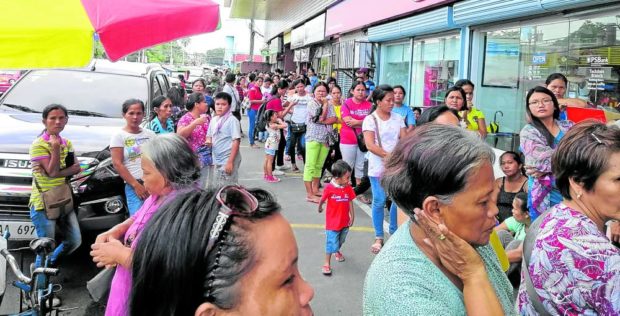
WAITING IN LINE Beneficiaries of the Pantawid Pamilyang Pilipino Program or 4Ps wait for their turn to get their financial aid from the government in one of the banks in Tacloban City in this photo taken in 2021. —JOEY GABIETA
BACOLOD CITY — A total of 161,431 beneficiaries of the Pantawid Pamilyang Pilipino Program (4Ps) in the Visayas have been delisted by the Department of Social Welfare and Development (DSWD).
Western Visayas topped the list with 87,678 beneficiaries, followed by 17,639 in Central Visayas, and 56,114 in Eastern Visayas, records from the DSWD in these regions showed.
May Rago-Castillo, regional public information officer of the DSWD in Western Visayas, said those removed from the list were already considered to be “non-poor” based on their assessment.
A “non-poor” household means that this family would no longer need the cash aid since the children have already graduated and found work, Social Welfare Secretary Erwin Tulfo said last month.
At least 1.3 million of the 4.3 million 4Ps beneficiaries nationwide were to be removed from the list, the DSWD previously announced.
READ: DSWD: 1.3 million 4Ps recipients may be dropped, their ‘poor’ status being checked
Cleansing
Among the provinces in Western Visayas, only beneficiaries from Negros Occidental was spared. Removed from the list were 8,692 households in Aklan; 8,829 in Antique; 18,691 in Capiz; 3,303 in Guimaras; and 24,476 in Iloilo.
However, 134,930 new poor households were being eyed as potential beneficiaries of the 4Ps in the region this year, she added.
Delia Bagolcol, officer in charge of the DSWD in Western Visayas, said the new beneficiaries would replace those nonpoor households who already graduated or exited from the program.
“The cleansing of the 4Ps list was done in response to the directive of the President to ensure that only qualified households must be receiving assistance from the government, particularly in the implementation of the 4Ps,” she explained.
Nowhere to be found
In Central Visayas, the government removed 17,639 beneficiaries from the 4Ps.
Leah Quintana, the DSWD regional information officer, said those removed from the list had failed to comply with some requirements, such as sending children or other members of the household to school. Others who were delisted were beneficiaries who changed residence or relocated without notice and could no longer be found by the DSWD.
Cebu province had the most number of delisted beneficiaries in the region at 7,897 as of Aug. 2, followed by Bohol (4,918), Negros Oriental (4,740), and Siquijor (84).
Quintana said the replacement for the delisted beneficiaries would come from the identified poor households on the agency’s list.
In Eastern Visayas, 56,114 beneficiaries of the 4Ps were removed from the list.
The DSWD in Eastern Visayas also cited similar reasons for delisting beneficiaries, such as relocating without notifiying the office and for having children who were no longer eligible for the program.
The 4Ps is a conditional cash transfer program of the government under the DSWD to help eradicate extreme poverty in the country for a maximum period of seven years by investing in health and education of persons from ages 0 to 18 from extremely poor households.
Beneficiaries receive P6,000 a year or P500 per month per household for health and nutrition expenses, and P3,000 for one school year (10 months) per child for educational expenses of up to three qualified children.
READ: 1.3 million families taken off 4Ps: ‘Grads’ from utter poverty
Rating system
The DSWD has designed a rating system to delineate poverty thresholds using the proxy means test (PMT), a statistical model that approximates household income based on household characteristics such as educational attainment, livelihood or occupation of household members, and the appliances, pieces of furniture and other household assets they owned.
The data on the targeted poor households were collected through a comprehensive, objective and transparent house-to-house assessment, the agency said.
Among the requirements for a household to be admitted to the 4Ps include having a pregnant member, studying children or members aged 0 to 18, and the willingness to comply with the program’s rules.
Eligible beneficiaries of the 4Ps include farmers, fishers, homeless families, indigenous peoples, those in the informal settler sector and those in geographically isolated and disadvantaged areas including those in areas without electricity.

